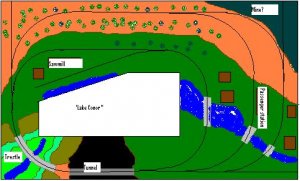Hmmm... You are modeling in HO, right?
There are some immediate problems I see with your plan. First, you mentioned 3 foot reaches earlier--so I assume your plan is six feet wide and, oh, about ten feet long.
Normally, the sharpest curves used with any regularity on HO scale model railroads are 18" (or 15" in a pinch.) The inside loop that goes from the mainline to the lumber mill and back looks like it would have to be aroun 12" in radius. While this is acceptable for very short locomotives (0-4-0 steam or very small diesels) and small logging disconnects, which are found in logging operations, full-sized passenger equipment will pitch right off the rails on curves that sharp (passenger cars from the 1920's onward were 60-80 feet long.) You had mentioned wanting full-sized passenger operations and those curves will effectively prevent that from happening.
Second, that three-feet reach will make access to the middle of the layout impossible--ESPECIALLY because it appears that the edges of the layout will have the highest elevation, with the lowest points (the lake and the river) in the middle. There is a solution for this--make a drop-out access hole in the lake. When you need to get access to the center of the layout (and believe me, you will need to) you just drop the hatch, which would be the lake's surface, and rise up out of the lake (THE LOCH NESS CONOR!!) to rerail things.
Third: On American prototypes, railroads typically get access to industries via single-ended spur tracks rather than double-ended sidings like you have on your plan (I think they're called "loops" in UK railroading parlance.) The lumber mill would not be located on the main, but rather on a spur off the main.
The river/lake is a good idea, though: many American logging operations dumped their logs into a "log pond" for storage, and the logs were later fished out of the drink for cutting. Logging railroads also commonly followed streambeds or rivers because they were the easiest ways to get through mountainous country (and often needed sharp turns.)
There are some immediate problems I see with your plan. First, you mentioned 3 foot reaches earlier--so I assume your plan is six feet wide and, oh, about ten feet long.
Normally, the sharpest curves used with any regularity on HO scale model railroads are 18" (or 15" in a pinch.) The inside loop that goes from the mainline to the lumber mill and back looks like it would have to be aroun 12" in radius. While this is acceptable for very short locomotives (0-4-0 steam or very small diesels) and small logging disconnects, which are found in logging operations, full-sized passenger equipment will pitch right off the rails on curves that sharp (passenger cars from the 1920's onward were 60-80 feet long.) You had mentioned wanting full-sized passenger operations and those curves will effectively prevent that from happening.
Second, that three-feet reach will make access to the middle of the layout impossible--ESPECIALLY because it appears that the edges of the layout will have the highest elevation, with the lowest points (the lake and the river) in the middle. There is a solution for this--make a drop-out access hole in the lake. When you need to get access to the center of the layout (and believe me, you will need to) you just drop the hatch, which would be the lake's surface, and rise up out of the lake (THE LOCH NESS CONOR!!) to rerail things.
Third: On American prototypes, railroads typically get access to industries via single-ended spur tracks rather than double-ended sidings like you have on your plan (I think they're called "loops" in UK railroading parlance.) The lumber mill would not be located on the main, but rather on a spur off the main.
The river/lake is a good idea, though: many American logging operations dumped their logs into a "log pond" for storage, and the logs were later fished out of the drink for cutting. Logging railroads also commonly followed streambeds or rivers because they were the easiest ways to get through mountainous country (and often needed sharp turns.)


